CSC413 Neural Networks and Deep Learning
Lecture 2
Last Week
- Review of linear models
- linear regression
- linear classification (logistic regression)
- Gradient descent to train these models
This Week
- Biological and Artifical Neurons
- Limitations of Linear Models for Classification
- Multilayer Perceptrons
- Backpropagation
Biological and Artificial Neurons
Neuron
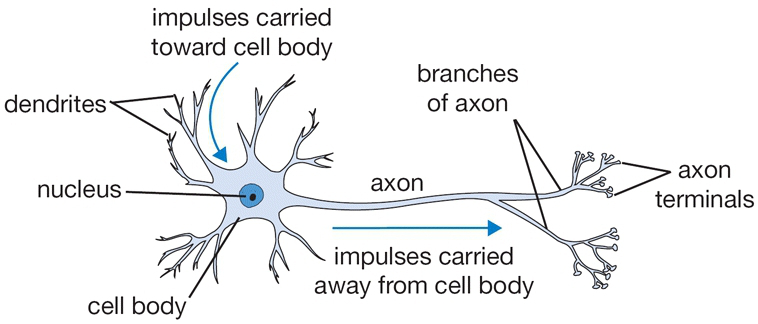
Neuron Anatomy
- The dendrites, which are connected to other cells that provide information.
- The cell body, which consolidates information from the dendrites.
- The axon, which is an extension from the cell body that passes information to other cells.
- The synapse, which is the area where the axon of one neuron and the dendrite of another connect.
What does a neuron do?
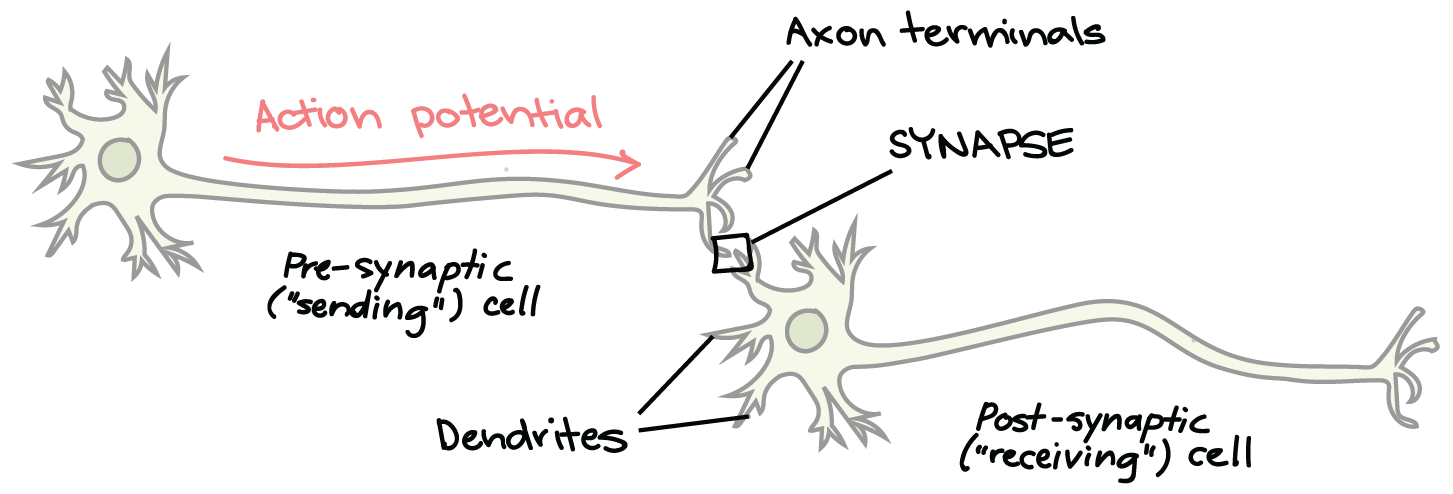
- Consolidates “information” (voltage difference) from its dendrites
- If the total activity in a neuron’s dendrite lowers the voltage difference enough, the entire cell depolarizes and the neuron fires
What does a neuron do?

- The voltage signal spreads along the axon and to the synapse, then to the next neurons
- Neuron sends information to the next cell
What makes a neuron fire?
Neurons can fire in response to…
- retinal cells
- certain edges, lines, angles, movements
- hands and faces (in primates)
- specific people (in humans)
- although the existence of these “grandmother cells” is contested
Modeling Individual Neurons
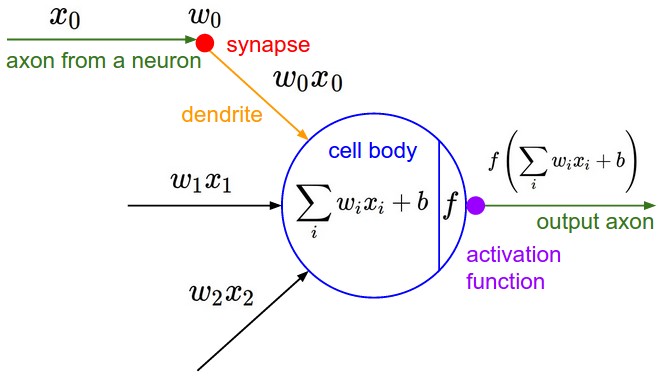
- \(x_{i}\) are inputs to the neuron
- \(w_{i}\) are the neuron’s weights
- \(b\) is the neuron’s bias
Modeling Individual Neurons II

- \(f\) is an activation function
- \(f(\sum_i x_i w_i + b)\) is the neuron’s activation (output)
Linear Models as a Single Neuron

- \(x_{i}\) are the inputs
- \(w_{i}\) are components of the weight vector \({\bf w}\)
- \(b\) is the bias
Linear Models as a Single Neuron II

- \(f\) is the identity function
- \(y = \sum_i x_i w_i + b = {\bf w}^\top {\bf x} + b\) is the output
Logistic Regression Models (for Binary Classification) as a Single Neuron

- \(x_{i}\) are the inputs
- \(w_{i}\) are components of the weight vector \({\bf w}\)
- \(b\) is the bias
Logistic Regression Models (for Binary Classification) as a Single Neuron II

- \(f = \sigma\)
- \(y = \sigma(\sum_i x_i w_i + b) = \sigma({\bf w}^\top {\bf x} + b)\)
Logistic Regression Models (for Multi-Class Classification) as a Neural Network
We use \(K\) neurons (one for each class):
- \(x_{i}\) are the inputs
- \(w_{j,i}\) are components of the weight matrix \(W\in \mathbb{R}^{K\times N}\)
- \(b_i\) are components of the bias vector \({\bf b}\)
- \(f = \text{softmax}\) : applied to the entire vector of values
- \({\bf y} = \text{softmax}(W{\bf x} + {\bf b})\) : outputs of \(K\) neurons
Limits of Linear Models for Binary Classification
XOR example
- Single neurons (linear classifiers) are very limited in expressive power
- XOR is a classic example of a function that’s not linearly separable, with an elegant proof using convexity
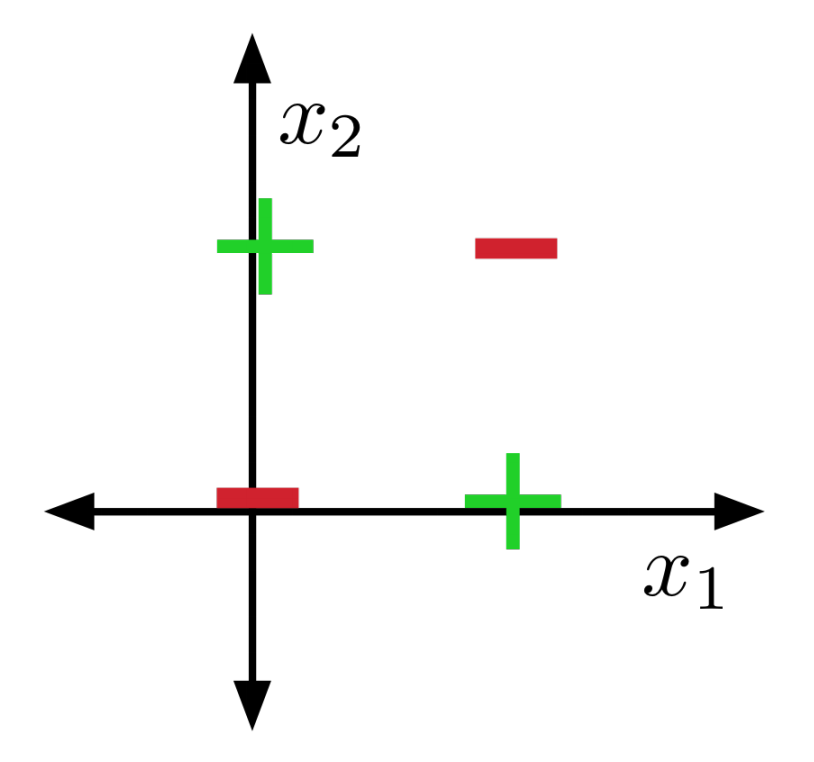
Convex Sets
A set \(S\subseteq\mathbb{R}^n\) is convex if any line segment connecting points in \(S\) lies in \(S\).
More formally, \(S\) is convex iff
\[{\bf x_1}, {\bf x_2} \in S \implies \forall \lambda \in [0,\, 1],\, \lambda {\bf x_1} + (1 - \lambda){\bf x_2} \in S.\]
A simple inductive argument shows that for \({\bf x_1}, \dots, {\bf x_N} \in S\), the weighted average or convex combination lies in the set:
\[\lambda_1 {\bf x_1} + \dots + \lambda_N {\bf x_N} \in S \text{ for }\lambda_1 + \dots + \lambda_N = 1\ .\]
XOR not linearly separable
Initial Observations
- A binary linear classifier divides the euclidean space into two half-spaces
- Half-spaces are convex
XOR not linearly separable II
- Suppose there were some feasible hypothesis. If the positive examples are in the positive half-space, then the green line segment must be as well.
- Similarly, red line segment must lie within the negative half-space.
- But the intersection can’t lie in both half-spaces. Contradiction!
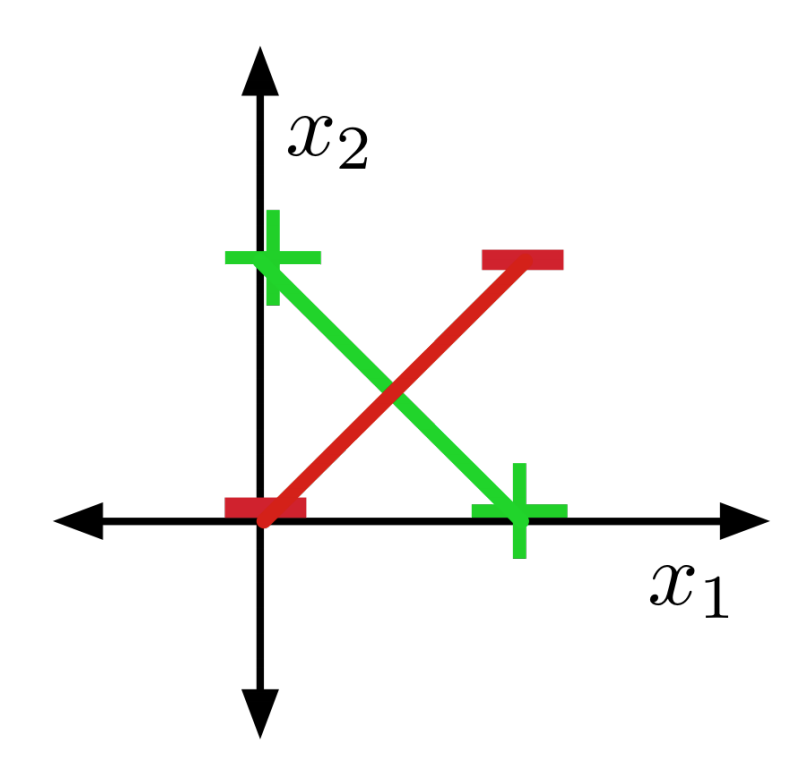
History of the XOR Example
- Minsky and Papert shown in their work Perceptrons that XOR cannot be learned by a Neuron.
- Its pessimistic outlook on perceptrons is assumed as one of the causes for the AI winter of the 70s / early 80s.
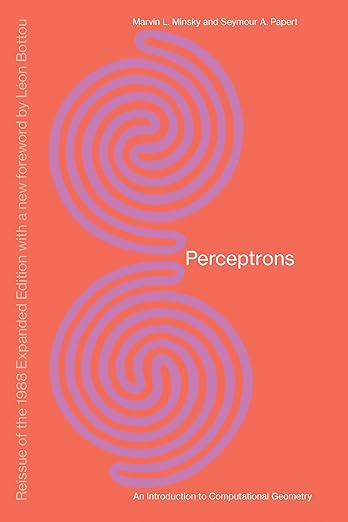
A more troubling example

These images represent 16-dimensional vectors. Want to distinguish patterns A and B in all possible translations (with wrap-around).
Suppose there’s a feasible solution. The average of all translations of A is the vector (0.25, 0.25, . . . , 0.25). Therefore, this point must be classified as A. All translations of B have the same average. Contradiction!
(Nonlinear) Feature Maps
Sometimes, we can overcome this limitation with nonlinear feature maps.
Nonlinear feature maps transform the original input features into a different (often higher dimensional) representation.
Consider the XOR problem again and use the following feature map: \[\Psi({\bf x}) = \begin{pmatrix}x_1 \\ x_2 \\ x_1x_2 \end{pmatrix}\]
(Nonlinear) Feature Maps II
| \(x_1\) | \(x_2\) | \(\phi_1({\bf x})\) | \(\phi_2({\bf x})\) | \(\phi_3({\bf x})\) | t |
|---|---|---|---|---|---|
| 0 | 0 | 0 | 0 | 0 | 0 |
| 0 | 1 | 0 | 1 | 0 | 1 |
| 1 | 0 | 1 | 0 | 0 | 1 |
| 1 | 1 | 1 | 1 | 1 | 0 |
This is linearly separable (Try it!)
… but generally, it can be hard to pick good basis functions.
We’ll use neural nets to learn nonlinear hypotheses directly
Multilayer Perceptrons
An Artificial Neural Network (Multilayer Perceptron)

Idea
- Use a simplified (mathematical) model of a neuron as building blocks
- Connect the neurons together accross multiple layers.
An Artificial Neural Network (Multilayer Perceptron) II

- An input layer: feed in input features (e.g. like retinal cells in your eyes)
- A number of hidden layers: don’t have specific meaning
- An output layer: interpret output like a “grandmother cell”
But what do these neurons mean?
- Use \(x_i\) to encode the input
- e.g. pixels in an image
- Use \(y\) to encode the output (of a binary classification problem)
- e.g. cancer vs. not cancer
- Use \(h_i^{(k)}\) to denote a unit in the hidden layer
- difficult to interpret
Example: MNIST Digit Recognition
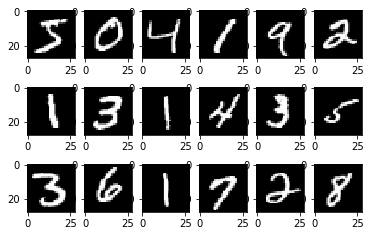
MNIST Digit Recognition II
With a logistic regression model, we would have:
- Input: An 28x28 pixel grayscale image
- \({\bf x}\) is a vector of length 784
- Target: The digit represented in the image
- \({\bf t}\) is a one-hot vector of length 10
- Model: \({\bf y} = \text{softmax}(W{\bf x} + {\bf b})\)
Adding a Hidden Layer
Two layer neural network
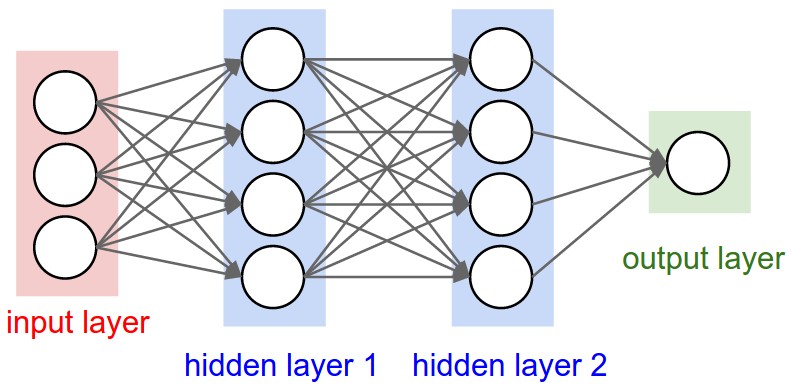
- Input size: 784 (number of features)
- Hidden size: 50 (we choose this number)
- Output size: 10 (number of classes)
Side note about machine learning models
When discussing machine learning and deep learning models, we usually
- first talk about how to make predictions assume the weights are trained
- then talk about how to train the weights
Often the second step requires gradient descent or some other optimization method
Making Predictions: computing the hidden layer

\[\begin{align*} h_1 &= f\left(\sum_{i=1}^{784} w^{(1)}_{1,i} x_i + b^{(1)}_1\right) \\ h_2 &= f\left(\sum_{i=1}^{784} w^{(1)}_{2,i} x_i + b^{(1)}_2\right) \\ ... \end{align*}\]
Making Predictions: computing the output (pre-activation)

\[\begin{align*} z_1 &= \sum_{j=1}^{50} w^{(2)}_{1,j} h_j + b^{(2)}_1 \\ z_2 &= \sum_{j=1}^{50} w^{(2)}_{2,j} h_j + b^{(2)}_2 \\ ... \end{align*}\]
Making Predictions: applying the output activation

\[\begin{align*} {\bf z} &= \begin{bmatrix}z_1 \\ z_2 \\ \vdots \\ z_{10}\end{bmatrix},\quad {\bf y} = \text{softmax}({\bf z}) \end{align*}\]
Making Predictions: Vectorized

\[\begin{align*} {\bf h} &= f(W^{(1)}{\bf x} + {\bf b}^{(1)}) \\ {\bf z} &= W^{(2)}{\bf h} + {\bf b}^{(2)} \\ {\bf y} &= \text{softmax}({\bf z}) \end{align*}\]
Activation Functions: common choices
Common Choices:
- Sigmoid activation
- Tanh activation
- ReLU activation
Rule of thumb: Start with ReLU activation. If necessary, try tanh.
Activation Function: Sigmoid
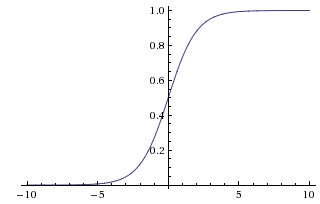
- Gradient vanishes at the extremes as the function converges to \(0\) and \(1\) respectively.
- All activations are positive (see this blog post to learn why we don’t want this)
Activation Function: Tanh
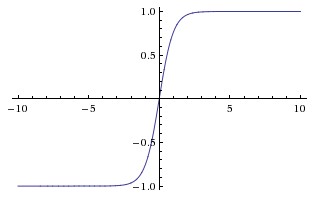
- scaled version of the sigmoid activation
- also somewhat problematic due to gradient signal
- activations can be positive or negative
Activation Function: ReLU
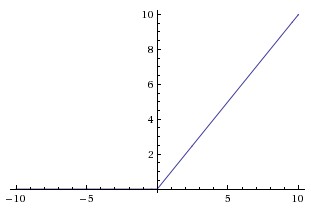
- most often used nowadays
- all activations are positive
- easy to compute gradients
- can be problematic if the bias is too large and negative, so the activations are always 0
Feature Learning
Neural nets can be viewed as a way of learning features:
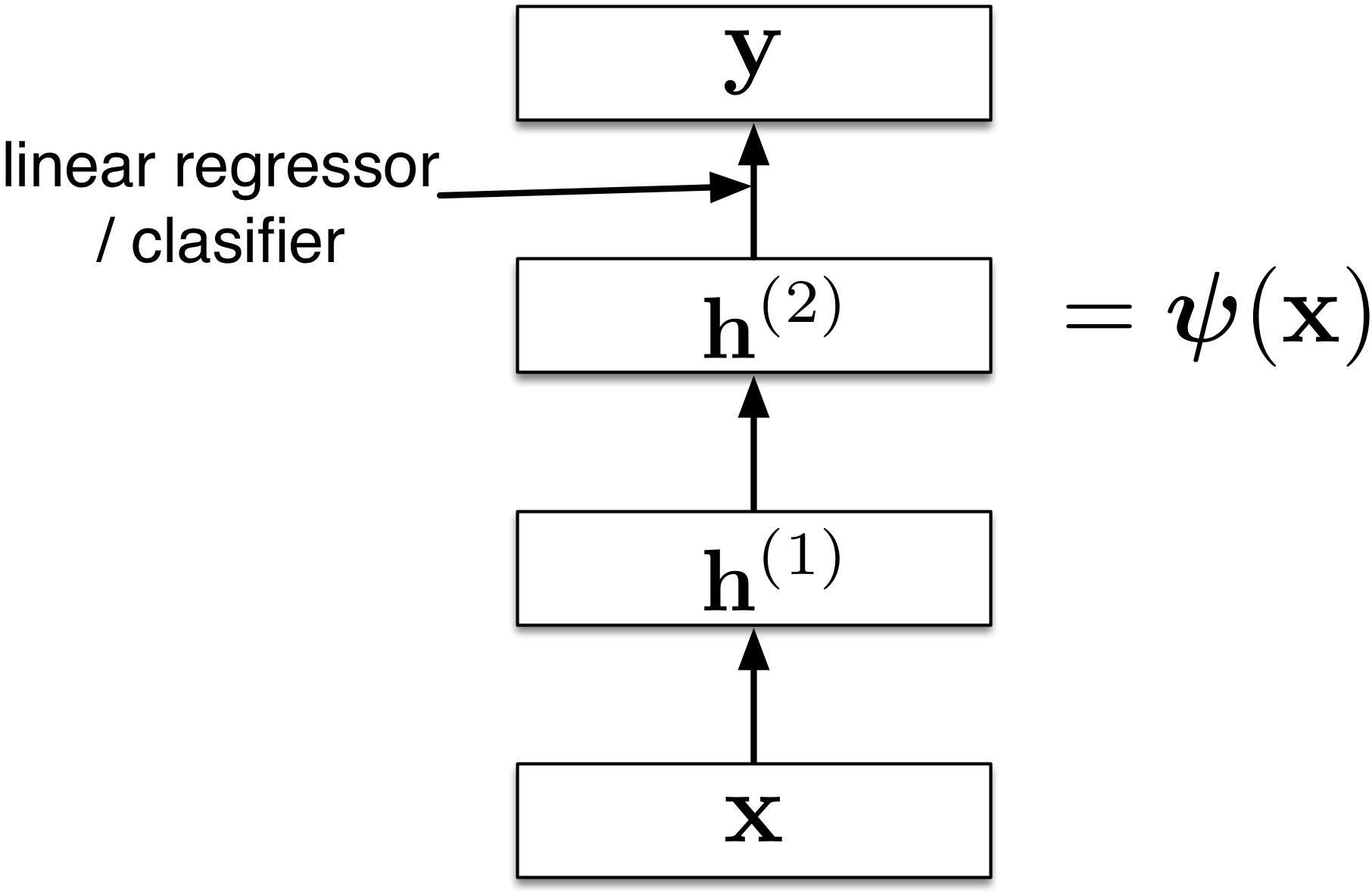
Feature Learning (cont’d)
The goal is for these features to become linearly separable:
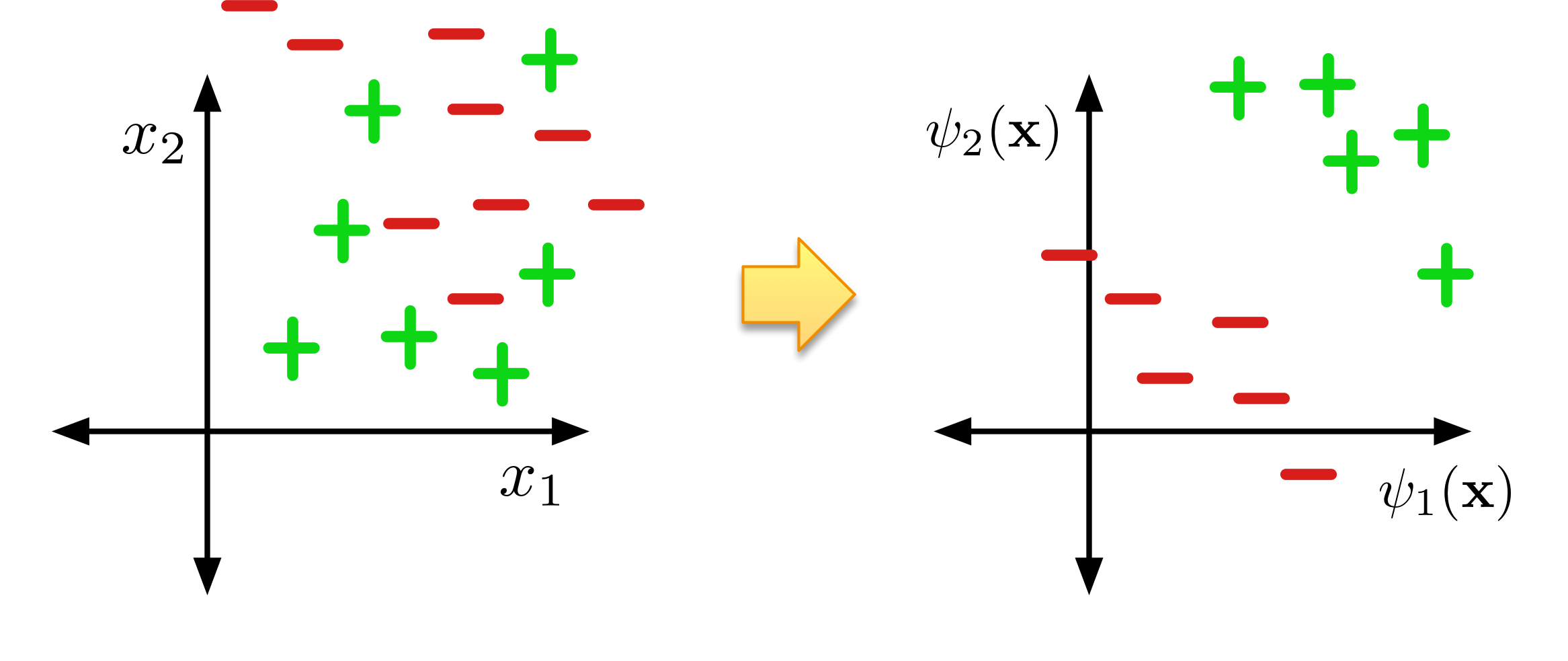
Computing XOR
Exercise: design a network to compute XOR
Use a hard threshold activation function:
\[\begin{align*} f(x) = \begin{cases} 1, & x \geq 0 \\ 0, & x < 0 \end{cases} \end{align*}\]
Computing XOR Demo
Expressive Power: Linear Layers (No Activation Function)
- We’ve seen that there are some functions that linear classifiers can’t represent. Are deep networks any better?
- Any sequence of layers (with no activation function) can be equivalently represented with a single linear layer.
\[\begin{align*} {\bf y} &= \left(W^{(3)} W^{(2)} W^{(1)}\right) {\bf x} \\ &= W^\prime {\bf x} \end{align*}\]
Expressive Power: MLP (nonlinear activation)
- Multilayer feed-forward neural nets with nonlinear activation functions are universal approximators: they can approximate any function arbitrarily well.
- This has been shown for various activation functions (thresholds, logistic, ReLU, etc.)
- Even though ReLU is “almost” linear, it’s nonlinear enough!
Universality for binary inputs and targets
- Hard threshold hidden units, linear output
- Strategy: \(2^D\) hidden units, each of which responds to one particular input configuration
- Only requires one hidden layer, though it needs to be extremely wide!
Limits of universality
- You may need to represent an exponentially large network.
- If you can learn any function, you might just overfit.
Backpropagation
Training Neural Networks
- How do we find good weights for the neural network?
- We can continue to use the loss functions:
- cross-entropy loss for classification
- square loss for regression
- The neural network operations we used (weights, etc) are (almost everywhere) differentiable
We can use gradient descent!
Gradient Descent Recap
Goal: Compute the minimum of a function \(\mathcal{E}({\bf a})\)
- Start with a set of parameters \(\mathbf{a}_0\) (initialize to some value)
- Compute the gradient \(\frac{\partial \mathcal{E}}{\partial \mathbf{a}}\).
- Update the parameters towards the negative direction of the gradient
Gradient Descent for Neural Networks
Idea: Use gradient descent for “learning” neural networks.
- We have a lot of parameters
- High dimensional (all weights and biases are parameters)
- Hard to visualize
- Many iterations (“steps”) needed
- In Deep Learning \(\frac{\partial \mathcal{E}}{\partial w}\) is the average of \(\frac{\partial \mathcal{L}}{\partial w}\) over multiple training examples
Challenge: How to compute \(\frac{\partial \mathcal{L}}{\partial w}\) effectively.
Solution: Backpropagation!
Univariate Chain Rule
Recall: if \(f(x)\) and \(x(t)\) are univariate functions, then
\[\frac{d}{dt}f(x(t)) = \frac{df}{dx}\frac{dx}{dt}\]
Univariate Chain Rule for Least Squares with a Logistic Model
Recall: Univariate logistic least squares model
\[\begin{align*} z &= wx + b \\ y &= \sigma(z) \\ \mathcal{L} &= \frac{1}{2}(y - t)^2 \end{align*}\]
Let’s compute the loss derivative
Univariate Chain Rule Computation I
How you would have done it in calculus class
\[\begin{align*} \mathcal{L} &= \frac{1}{2} ( \sigma(w x + b) - t)^2 \\ \frac{\partial \mathcal{L}}{\partial w} &= \frac{\partial}{\partial w} \left[ \frac{1}{2} ( \sigma(w x + b) - t)^2 \right] \\ &= \frac{1}{2} \frac{\partial}{\partial w} ( \sigma(w x + b) - t)^2 \\ &= (\sigma(w x + b) - t) \frac{\partial}{\partial w} (\sigma(w x + b) - t) \\ &\ldots \end{align*}\]
Univariate Chain Rule Computation II
How you would have done it in calculus class
\[\begin{align*} \ldots &= (\sigma(w x + b) - t) \frac{\partial}{\partial w} (\sigma(w x + b) - t) \\ &= (\sigma(w x + b) - t) \sigma^\prime (w x + b) \frac{\partial}{\partial w} (w x + b) \\ &= (\sigma(w x + b) - t) \sigma^\prime (w x + b) x \end{align*}\]
Univariate Chain Rule Computation III
Similarly for \(\frac{\partial \mathcal{L}}{\partial b}\)
\[\begin{align*} \mathcal{L} &= \frac{1}{2} ( \sigma(w x + b) - t)^2 \\ \frac{\partial \mathcal{L}}{\partial b} &= \frac{\partial}{\partial b} \left[ \frac{1}{2} ( \sigma(w x + b) - t)^2 \right] \\ &= \frac{1}{2} \frac{\partial}{\partial b} ( \sigma(w x + b) - t)^2 \\ &= (\sigma(w x + b) - t) \frac{\partial}{\partial b} (\sigma(w x + b) - t) \\ &\ldots \end{align*}\]
Univariate Chain Rule Computation IV
Similarly for \(\frac{\partial \mathcal{L}}{\partial b}\)
\[\begin{align*} \ldots &= (\sigma(w x + b) - t) \frac{\partial}{\partial b} (\sigma(w x + b) - t) \\ &= (\sigma(w x + b) - t) \sigma^\prime (w x + b) \frac{\partial}{\partial b} (w x + b) \\ &= (\sigma(w x + b) - t) \sigma^\prime (w x + b) \end{align*}\]
Q: What are the disadvantages of this approach?
A More Structured Way to Compute the Derivatives
\[\begin{align*} z &= wx + b \\ y &= \sigma(z) \\ \mathcal{L} &= \frac{1}{2}(y - t)^2 \end{align*}\]
Less repeated work; easier to write a program to efficiently compute derivatives
A More Structured Way to Compute the Derivatives II
\[\begin{align*} \frac{d \mathcal{L}}{d y} &= y - t \\ \frac{d \mathcal{L}}{d z} &= \frac{d \mathcal{L}}{d y}\sigma'(z) \\ \frac{\partial \mathcal{L}}{\partial w} &= \frac{d \mathcal{L}}{d z} \, x \\ \frac{\partial \mathcal{L}}{\partial b} &= \frac{d \mathcal{L}}{d z} \end{align*}\]
Less repeated work; easier to write a program to efficiently compute derivatives
Computation Graph
We can diagram out the computations using a computation graph.
- The nodes represent all the inputs and computed quantities.
- The edges represent which nodes are computed directly as a function of which other nodes.
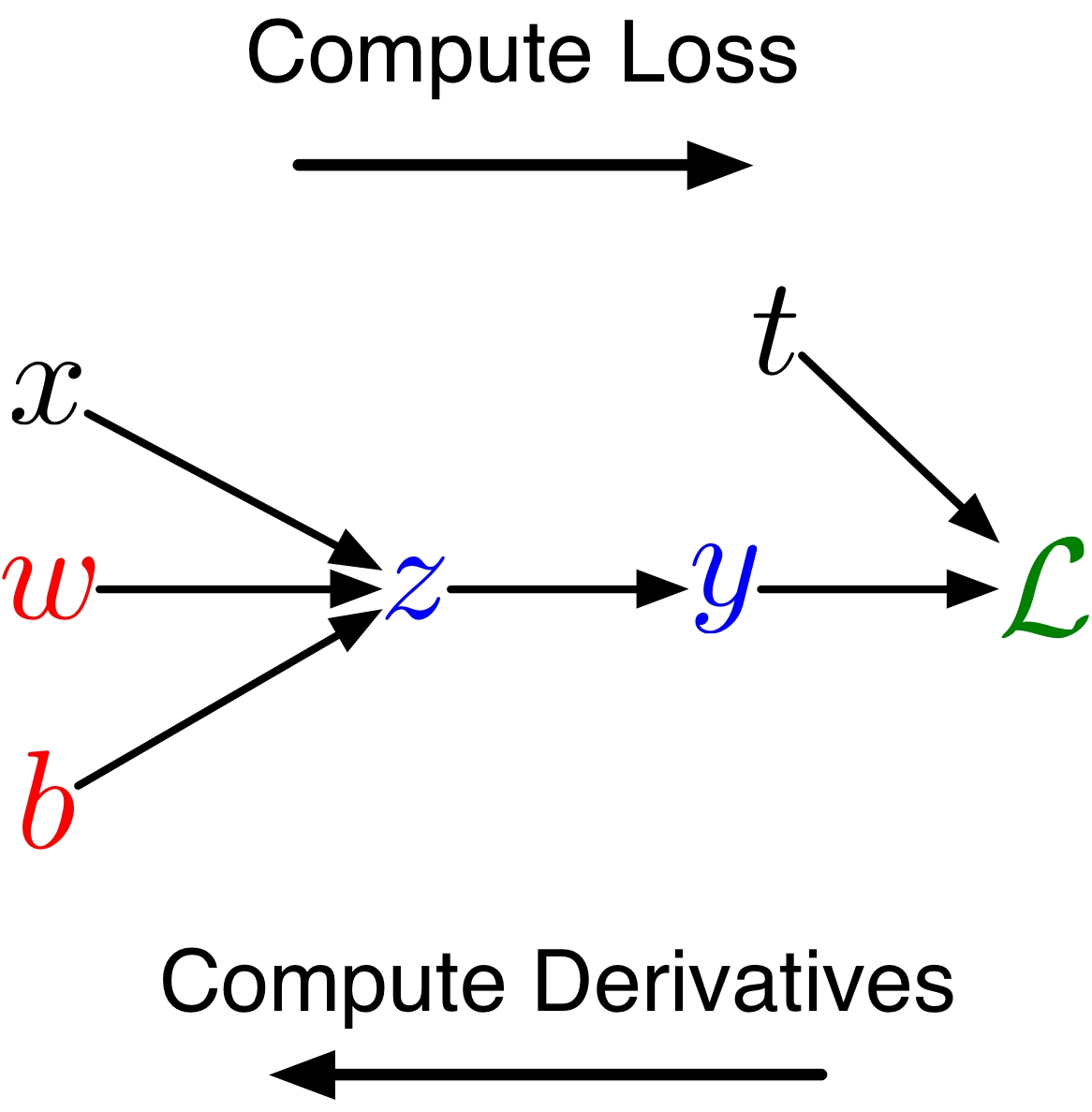
Chain Rule (Error Signal) Notation
- Use \(\overline{y}\) to denote the derivative \(\frac{d \mathcal{L}}{d y}\)
- sometimes called the error signal
- This notation emphasizes that the error signals are just values our program is computing (rather than a mathematical operation).
- This is notation introduced by Prof. Roger Grosse, and not standard notation
Chain Rule (Error Signal) Notation II
Computing the loss:
\[\begin{align*} z &= wx + b \\ y &= \sigma(z) \\ \mathcal{L} &= \frac{1}{2}(y - t)^2 \end{align*}\]
Computing the derivatives:
\[\begin{align*} \overline{y} &= y - t \\ \overline{z} &= \overline{y} \sigma'(z) \\ \overline{w} &= \overline{z} \, x \\ \overline{b} &= \overline{z} \end{align*}\]
Multiclass Logistic Regression Computation Graph
In general, the computation graph fans out:
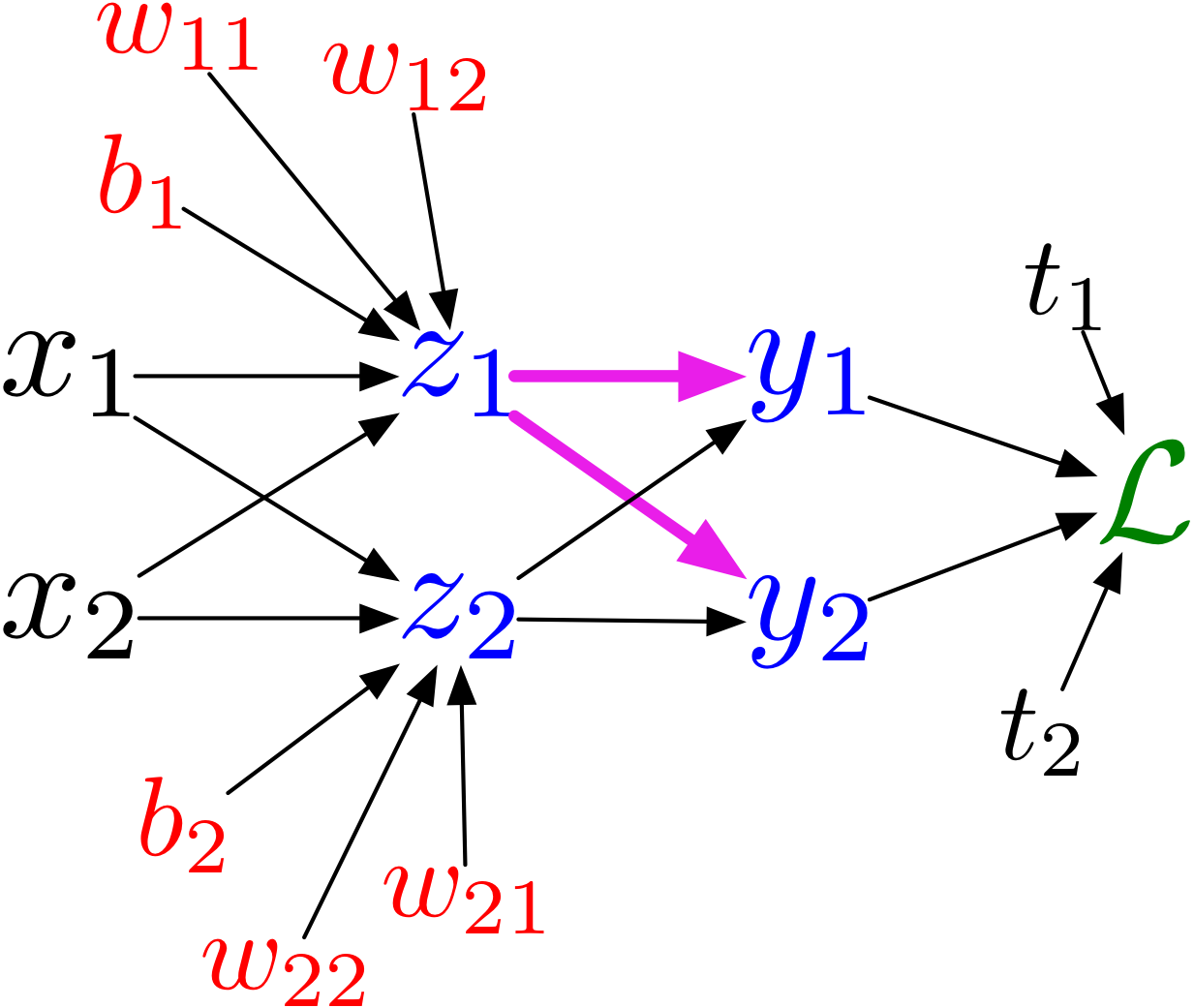
Multiclass Logistic Regression Computation Graph II
\[\begin{align*} z_l &= \sum_j w_{lj} x_j + b_l \\ y_k &= \frac{e^{z_k}}{\sum_l e^{z_l}} \\ \mathcal{L} &= -\sum_k t_k \log{y_k} \end{align*}\]
There are multiple paths for which a weight like \(w_{11}\) affects the loss \(\mathcal{L}\).
Multivariate Chain Rule
Suppose we have a function \(f(x, y)\) and functions \(x(t)\) and \(y(t)\) (all the variables here are scalar-valued). Then
\[\frac{d}{dt}f(x(t), y(t)) = \frac{\partial f}{\partial x}\frac{dx}{dt} + \frac{\partial f}{\partial y}\frac{dy}{dt}\]

Multivariate Chain Rule Example
If \(f(x, y) = y + e^{xy}\), \(x(t) = \cos t\) and \(y(t) = t^2\)…
\[\begin{align*} \frac{d}{dt}f(x(t), y(t)) &= \frac{\partial f}{\partial x}\frac{dx}{dt} + \frac{\partial f}{\partial y}\frac{dy}{dt} \\ &= \left( y e^{xy} \right) \cdot \left( -\sin (t) \right) + \left( 1 + xe^{xy} \right) \cdot 2t \end{align*}\]
Multivariate Chain Rule Notation

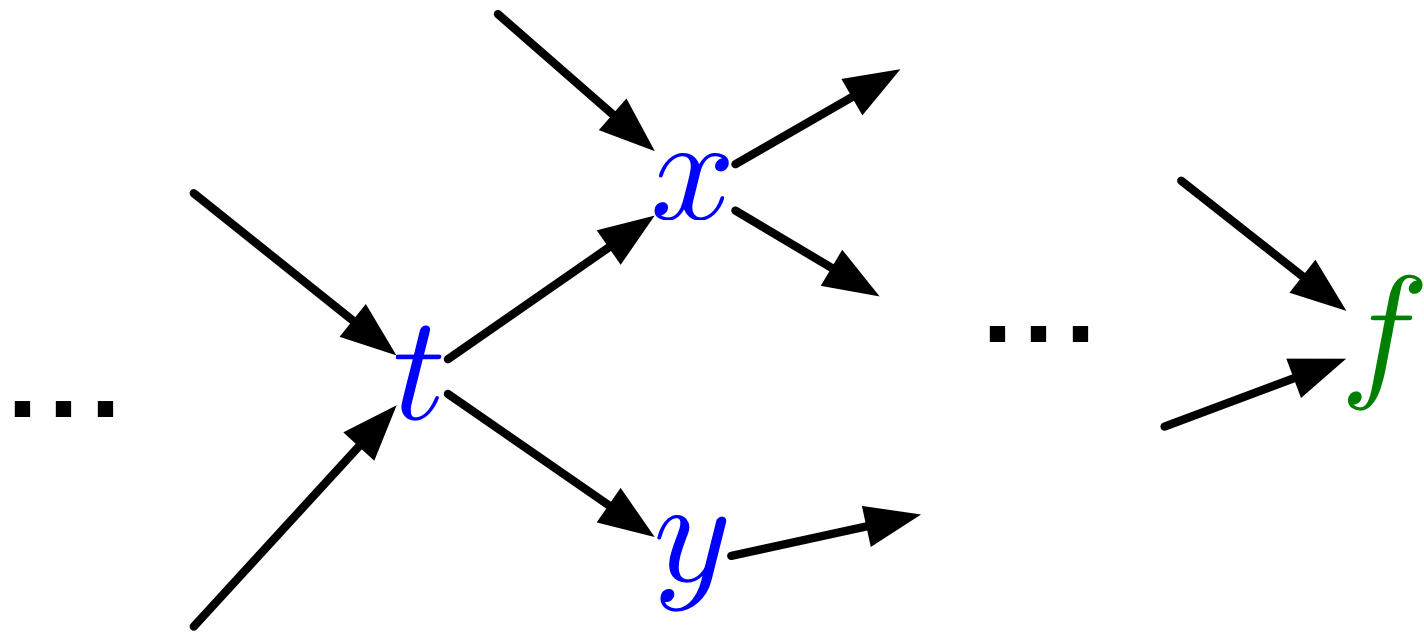
In our notation
\[\overline{t} = \overline{x} \frac{dx}{dt} + \overline{y} \frac{dy}{dt}\]
The Backpropagation Algorithm
- Backpropagation is an algorithm to compute gradients efficiency
- Forward Pass: Compute predictions (and save intermediate values)
- Backwards Pass: Compute gradients
- The idea behind backpropagation is very similar to dynamic programming
- Use chain rule, and be careful about the order in which we compute the derivatives
Backpropagation Example
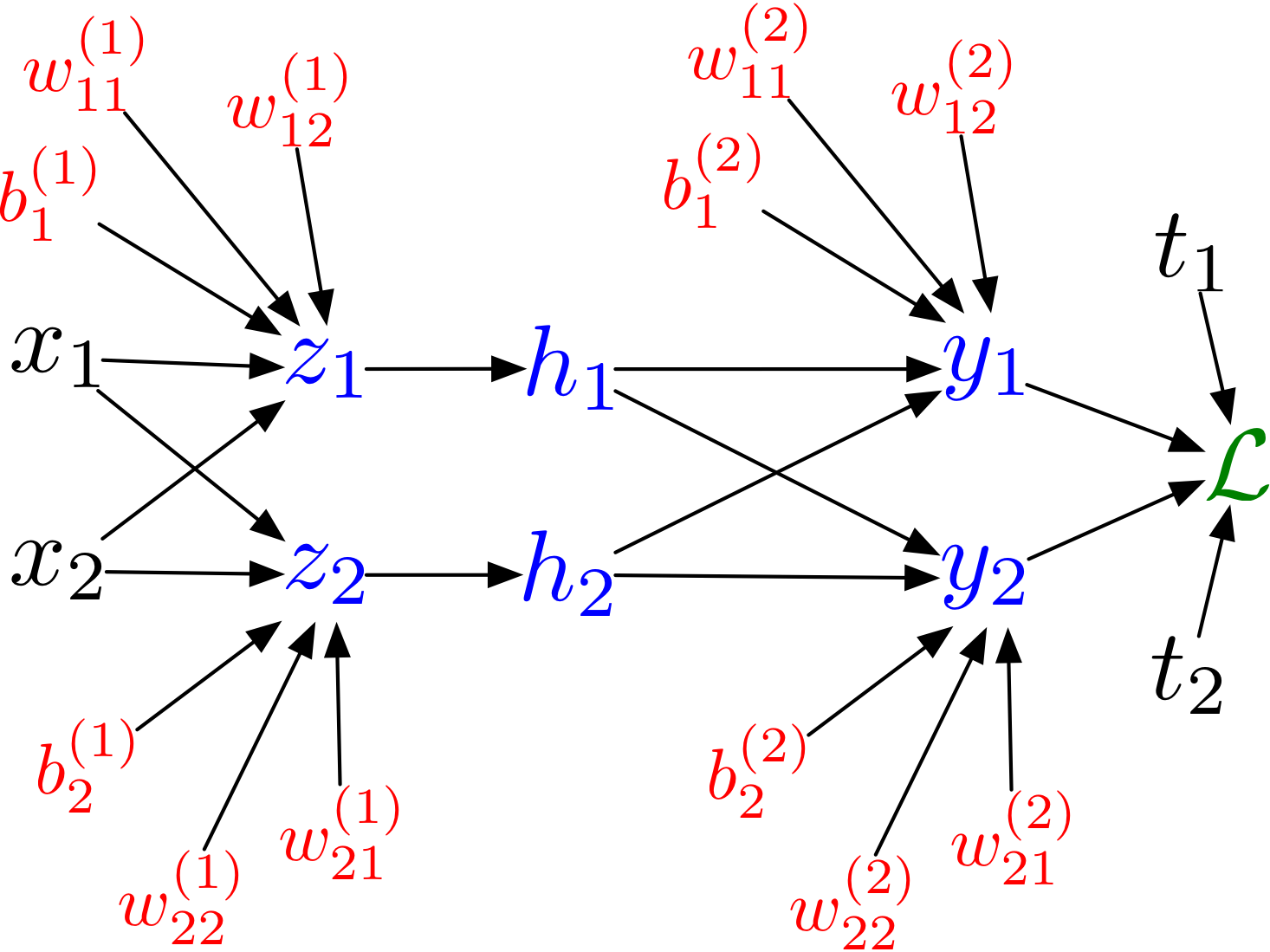
Backpropagation for a MLP
Forward pass: \[\begin{align*} z_i &= \sum_j w_{ij}^{(1)} x_j + b_i^{(1)} \\ h_i &= \sigma(z_i) \\ y_k &= \sum_i w_{ki}^{(2)} h_i + b_k^{(2)} \\ \mathcal{L} &= \frac{1}{2}\sum_k (y_k - t_k)^2 \end{align*}\]
Backpropagation for a MLP II
Backward pass:
\[\begin{align*} \overline{\mathcal{L}} &= 1 \\ \overline{y_k} &= \overline{\mathcal{L}}(y_k - t_k) \\ \overline{w_{ki}^{(2)}} &= \overline{y_k}h_i \\ \overline{b_{k}^{(2)}} &= \overline{y_k} \end{align*}\]
\[\begin{align*} \overline{h_i} &= \sum_k \overline{y_k} w_{ki}^{(2)} \\ \overline{z_i} &= \overline{h_i} \sigma'(z_i) \\ \overline{w_{ij}^{(1)}} &= \overline{z_i} x_j \\ \overline{b_{i}^{(1)}} &= \overline{z_i} \end{align*}\]
Backpropagation for a MLP
Forward pass: \[\begin{align*} {\bf z} &= W^{(1)}{\bf x} + {\bf b}^{(1)} \\ {\bf h} &= \sigma({\bf z}) \\ {\bf y} &= W^{(2)}{\bf h} + {\bf b}^{(2)} \\ \mathcal{L} &= \frac{1}{2} || {\bf y} - {\bf t}||^2 \end{align*}\]

Backpropagation for a MLP
Backward pass: \[\begin{align*} \overline{\mathcal{L}} &= 1 \\ \overline{{\bf y}} &= \overline{\mathcal{L}}({\bf y} - {\bf t}) \\ \overline{W^{(2)}} &= \overline{{\bf y}}{\bf h}^\top \\ \overline{{\bf b^{(2)}}} &= \overline{{\bf y}} \\ & \ldots \end{align*}\]

Backpropagation for a MLP
Backward pass: \[\begin{align*} & \ldots \\ \overline{{\bf h}} &= {W^{(2)}}^\top\overline{y} \\ \overline{{\bf z}} &= \overline{{\bf h}} \circ \sigma'({\bf z}) \\ \overline{W^{(1)}} &= \overline{{\bf z}} {\bf x}^\top \\ \overline{{\bf b}^{(1)}} &= \overline{{\bf z}} \end{align*}\]

Implementing Backpropagation I
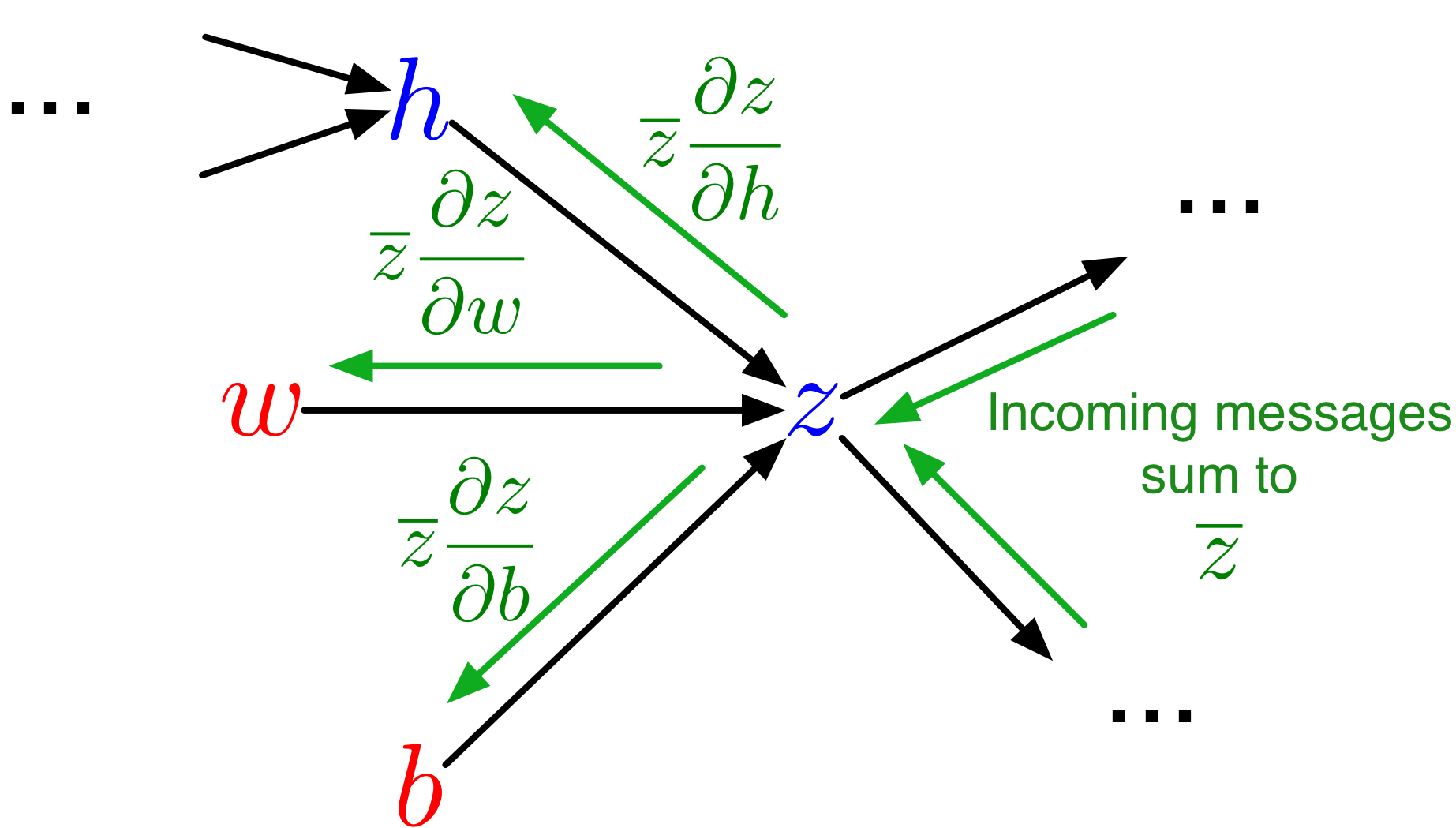
Implementing Backpropagation II
Forward pass: Each node…
- receives messages (inputs) from its parents
- uses these messages to compute its own values
Backward pass: Each node…
- receives messages (error signals) from its children
- uses these messages to compute its own error signal
- passes message to its parents
This algorithm provides modularity!
Backpropagation in Vectorized Form
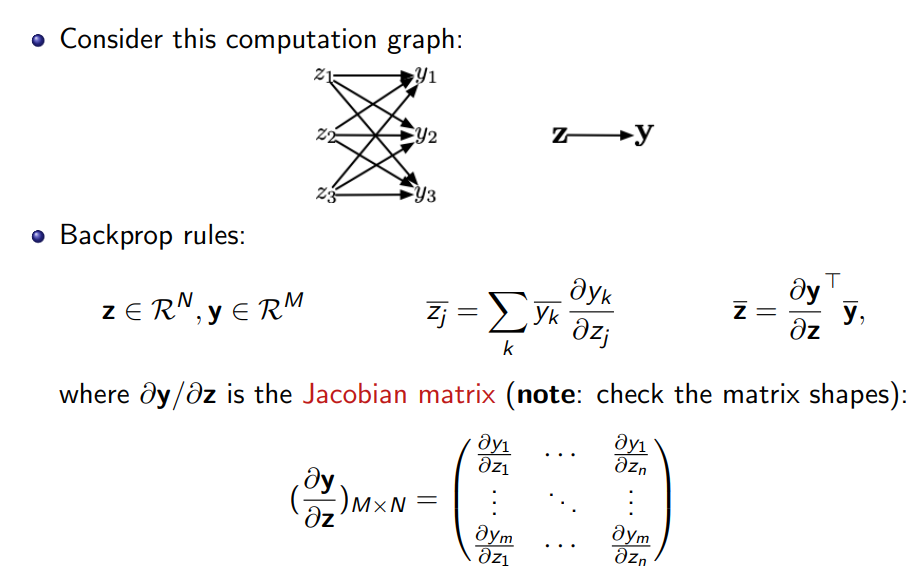
Backpropagation in practice
- Backprop is used to train the overwhelming majority of neural nets today.
- Even optimization algorithms much fancier than gradient descent (e.g.~second-order methods) use backprop to compute the gradients.
Backpropagation in practice II
- Despite its practical success, backprop is believed to be neurally (biologically) implausible.
- No evidence for biological signals analogous to error derivatives.
- All the biologically plausible alternatives we know about learn much more slowly (on computers).
Wrap Up
Summary
- Artificial neurons draw inspiration from nerve cells / neurons in the brain
- On its own, the expresiveness of a single neuron is limited
- Stacking neurons and nonlinear activation functions allows for learning more complex functions
- Backpropagation can be used for this learning task
What to do this week?
- You can already complete Assignment 1
- Start early so you can get help early!
- Attend tutorials this week!
- Complete the readings for this week.
- Preview next week’s materials